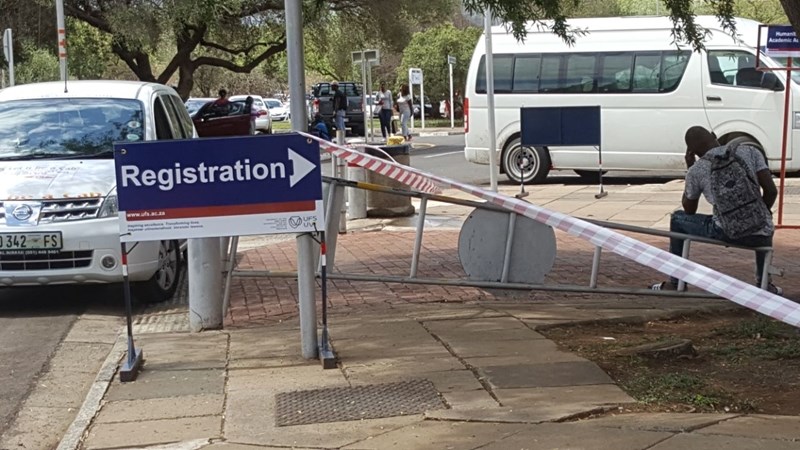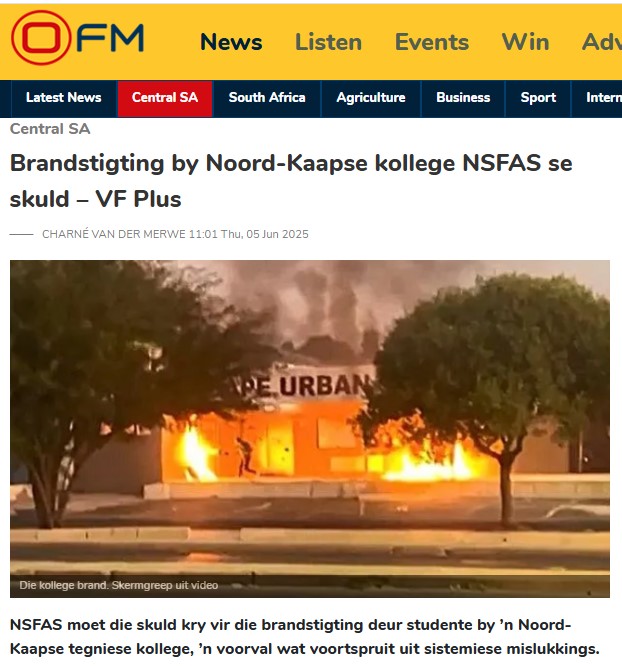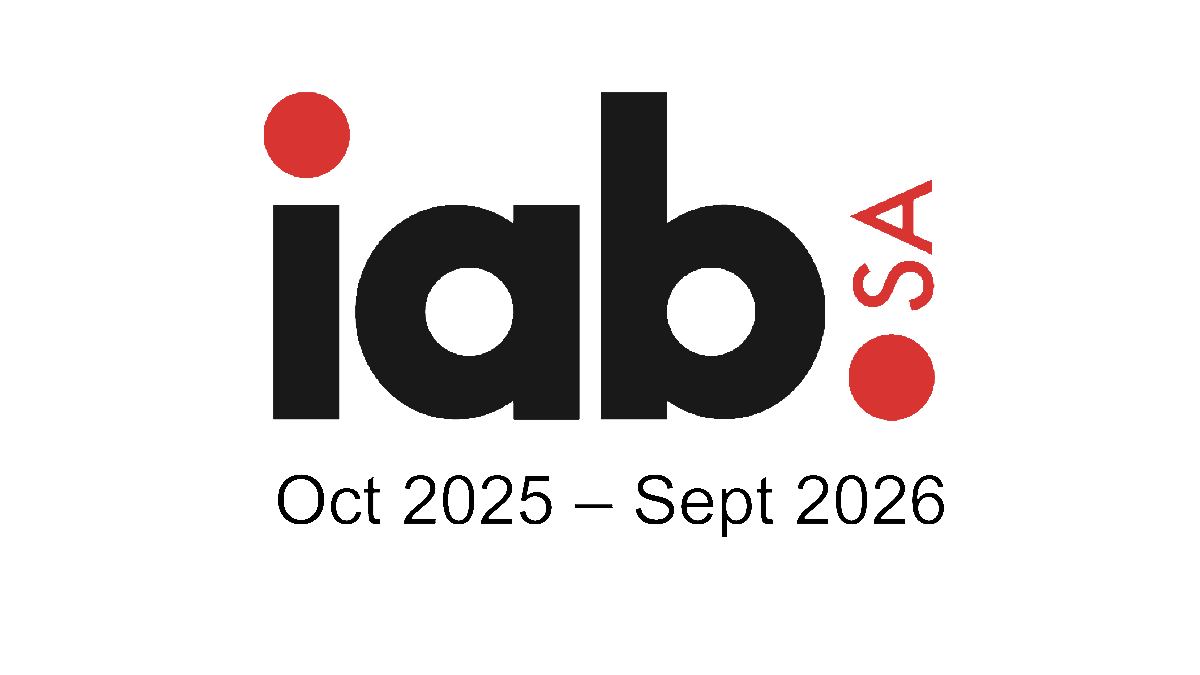South Africa
Some say NSFAS is too broken to succeed─── 06:00 Sat, 12 Jul 2025

After years of protests by students, calls are now also made by universities that the funding model of the National Student Financial Aid Scheme (NSFAS) must be reviewed.
“The dysfunction within NSFAS is negatively affecting the quality of education at institutions of higher learning,” the Deputy Vice-Chancellor for Teaching and Learning at the North-West University, Prof. Linda du Plessis, said.
While the focus has been on how the lack of funding affects students, the operational and financial toll on universities is overlooked. South Africa’s public universities are under immense pressure due to the dysfunction of NSFAS and SETAs, she warned. “Despite meticulous planning ... every academic year begins with chaos: delayed funding, defunding of students mid-year, and tens of thousands of students left in accommodation limbo.

Prof. Linda du Plessis. Photo: NWU
“What continues to receive little or no acknowledgement is the burden these failures place on the very institutions tasked with delivering quality higher education: the public universities.”
She explains that universities, often without consultation or support, are forced to cover registration and tuition fees, manage housing crises, and endure delays in NSFAS disbursements.
“These challenges disrupt academic calendars, inflate costs, and compromise infrastructure maintenance. While higher education budgets rise, most of the increase goes to NSFAS – not to innovation or institutional growth. “Public universities are not just service providers, they are national assets ... shaping the future workforce of South Africa.”
SETAs also add strain due to mismanagement and political interference, failing to support crucial work-integrated learning. “Sustaining excellence within a failing system is difficult.”
Background
“Most underprivileged households in South Africa are dependent on NSFAS, to ensure their children receive a university education. This is mainly because of the unequal society created by the Apartheid era.” This is according to a study, NSFAS crisis: Theory of communicative action by Rene W. Albertus and Frank Makoza, published in February this year.
“However, the government of South Africa views higher education as a means of human capital development to increase the skills required in the various sectors of the economy. Furthermore, higher education is perceived as a means of empowering communities to overcome poverty, exclusion and inequality. Consequently, NSFAS was introduced in 1998, and the number of students applying for and benefiting from the scheme has increased continuously over the years.
As we approach the second semester, it's unfortunate that the NSFAS crisis remains catastrophically unresolved. Despite our relentless efforts to engage with the administration, they continue to protect the Minister at all costs ignoring the pleas of students. #NKABANEMUSTRESIGN pic.twitter.com/kfsbAiO2bb
— South African Students Federation ( SASF ) (@SouthSasf2110) July 8, 2025
“NSFAS support could be in the form of a loan, grant or bursary. With a loan, students are liable to repay after they have completed their studies and become gainfully employed (earning R30,000 and above per annum). A grant or bursary is offered to meet a financial need, with no financial obligation for repayment. The NSFAS students’ support covers meals, tuition fees, book allowance, accommodation and transport. Students, who meet the following criteria, are eligible to apply for NSFAS support:
- South African citizens with a national identity (ID) number;
- intending to register, and registered at a public university, or technical and vocational college; and
- household income of not more than R360,000.
Successful applicants are notified, and the tuition fees segment of the loans is paid directly to their respective higher educational institutions. Monthly stipend payments are paid directly into the students’ bank accounts.
While the process may seem to be clear, in reality, it is challenging. NSFAS has struggled with the introduction of reliable structures to identify deserving recipients of NSFAS loans.
Some have mistakenly received NSFAS loans
Furthermore, students, who did not meet the criteria as eligible applicants, have mistakenly received NSFAS loans. Another challenge has been the backlog in the monthly payments of stipends to students, which has affected their ability to pay for services, such as accommodation, travel, as well as the acquisition of textbooks. This has affected the performance of students in their studies.
In addition, the government, through the Department of Treasury, has reduced the budget allocated to NSFAS, with the consequence of the organisation being unable to increase the number of students it supports.
Another challenge is related to the general administration of the organisation, and the moral hazard involving staff, leading to high staff turnover, as well as a leadership crisis within the organisation.
These NSFAS loans may be repayed
The sustainability of the NSFAS programme is challenging, as some students do not complete their studies, leaving the educational institutions with the loss of revenue from unpaid fees and NSFAS with the loss of repayments from the students. In some cases, students have been overpaid, leading to a loss of funds that could have been used to support additional students.
Yet another challenge that NSFAS faces is the repayment of loans by the students who have completed their studies. Students who received NSFAS loans may start to repay their loan once they are employed or receive an income of R30 000 per annum.
In 2019, NSFAS and the South African Revenue Services had an agreement to share information, in which SARS would provide details on the income and employer details of individuals, who had received an NSFAS loan or bursary. This implies that NSFAS loan repayments would only be received from students, who had completed their studies, and were employed.
NSFAS CEO has responded to our letter, and confirmed that the 4 middleman companies used by NSFAS to distribute money don’t have FSP Licenses, and have subcontracted a company called Netcash (Pty) Ltd.
— Sihle Lonzi (@SihleLonzi) July 8, 2025
The sooner we remove the ANC criminal syndicate the better for South Africa! pic.twitter.com/kT1U9lXtMR
In South Africa, however, the unemployment rate is considered to be among the highest rates worldwide. The unemployment of graduates impacted the repayments of NSFAS loans, as with fewer students repaying their loans, NSFAS would be unable to increase the number of loan recipients.
There is a dearth of academic research on alternative funding options for students, besides NSFAS, and a lack of appetite from private financial institutions to develop funding models that will assist students, who do not have parents to sign surety for conventional loans. Moreover, there are many unanswered questions about how financial institutions, in collaboration with South African Revenue Services, could create partnerships for student funding, as well as a culture of financial literacy and inclusion for future:
- How could the youth be educated on the repayment of NSFAS loans?
- Do they realise that non-payment of NSFAS loans would cripple the financing programme for future generations?
- What are the social and economic implications, if NSFAS continues to provide funding, with limited, or no, repayment?
?? Millions of students are locked out of opportunity while Minister Nkabane enables corruption and chaos at NSFAS and SETAs. From unsafe housing to mid-year defunding and years of delays, our students deserve better. The DA is fighting for accountability and real solutions. pic.twitter.com/X8qkvXnR8q
— Democratic Alliance (@Our_DA) July 1, 2025
Claims of corruption and irregularities in the administration of the NSFAS programme are rife, as a network of service providers and public servants was created, to assist each other in the tender process, and facilitate the looting at NSFAS. The institution failed to act on the claims, creating the impression that students were dependent on government handouts, while stripping them of the responsibility of managing the NSFAS debt. In addition, the crisis resulted in students’ protests at several higher education institutions in South Africa
South Africa’s higher education sector, serving more than 1.7 million students across universities, TVET colleges and CET institutions, promises quality learning, skills development and support. But each academic year opens with the same struggles – unpaid student debt, blocked registrations, and housing shortages that leave some students sleeping outside institutions.
??Minister Nkabane must be REMOVED! She lied to Parliament, enabled ANC cadre deployment and is the reason why the Department of Higher Education is failing students. NSFAS has lost millions to fraud instead of supporting students. We call for her removal and full accountability! pic.twitter.com/xVgfbFECRb
— Democratic Alliance (@Our_DA) July 1, 2025
Protests have become routine, driven largely by delays and dysfunction at the NSFAS, with issues ranging from slow funding to technical failures and poor governance.
It was for these reasons that Higher Education Minister Nobuhle Nkabane was brought in to steer the ship after the Government of National Unity (GNU) was formed, along with two deputies, Mimmy Gondwe and Buti Manamela. Nkabane arrived when entities such as NSFAS had been placed under administration over non-payment issues.
Despite pledging to fix NSFAS, Minister Nobuhle Nkabane faces mounting criticism as students continue suffering delayed allowances, evictions, and campus unrest, The Daily Maverick reported. While allowances increased and over 800,000 students were funded in 2025, NSFAS still owes millions to landlords and struggles with housing, operations, and confidence. TVET colleges remain under-resourced despite budget boosts. Safety issues plague campuses, with violence and infrastructure failures persisting. The Sector Education and Training Authorities (Setas) are under fire for political appointments, further eroding public trust. Student debt and unissued certificates lock graduates out of jobs. Some say NSFAS is too broken to succeed. Critics say reforms have fallen short, and calls for Nkabane’s removal are growing. NSFAS, too broken to succeed
NSFAS has just engaged in stakeholder workshops for the 2026 academic year, focusing on support for funded students.
Universities and TVET colleges owe NSFAS nearly R12 billion, a debt accumulated between 2017 and 2023. NSFAS is also working on streamlining student accommodation for all beneficiaries, piloting the system with selected institutions.
The solutions to these issues are critical to various stakeholders, namely, the government, students, parents and guardians, educators and financial institutions.
OFM News dg















